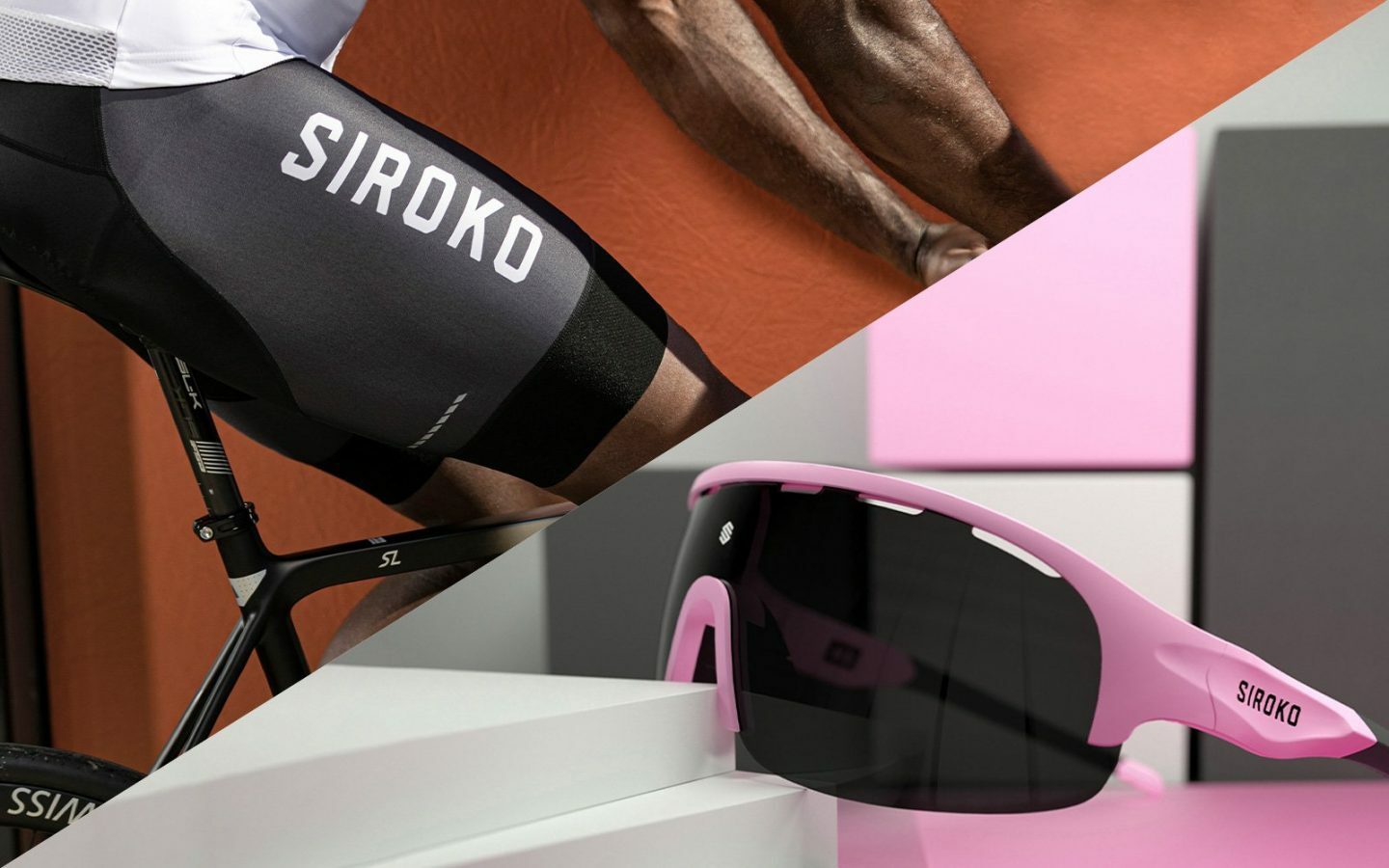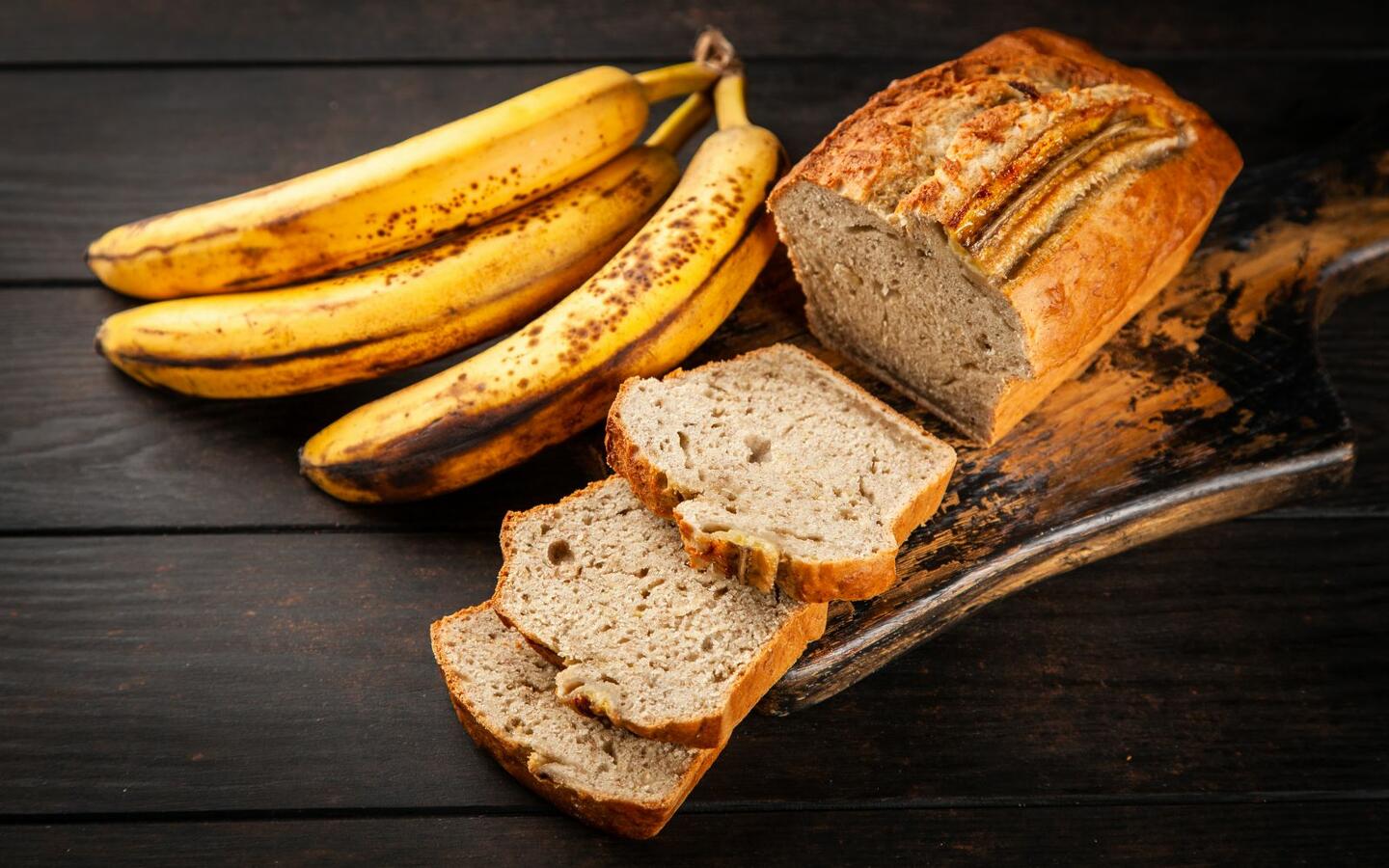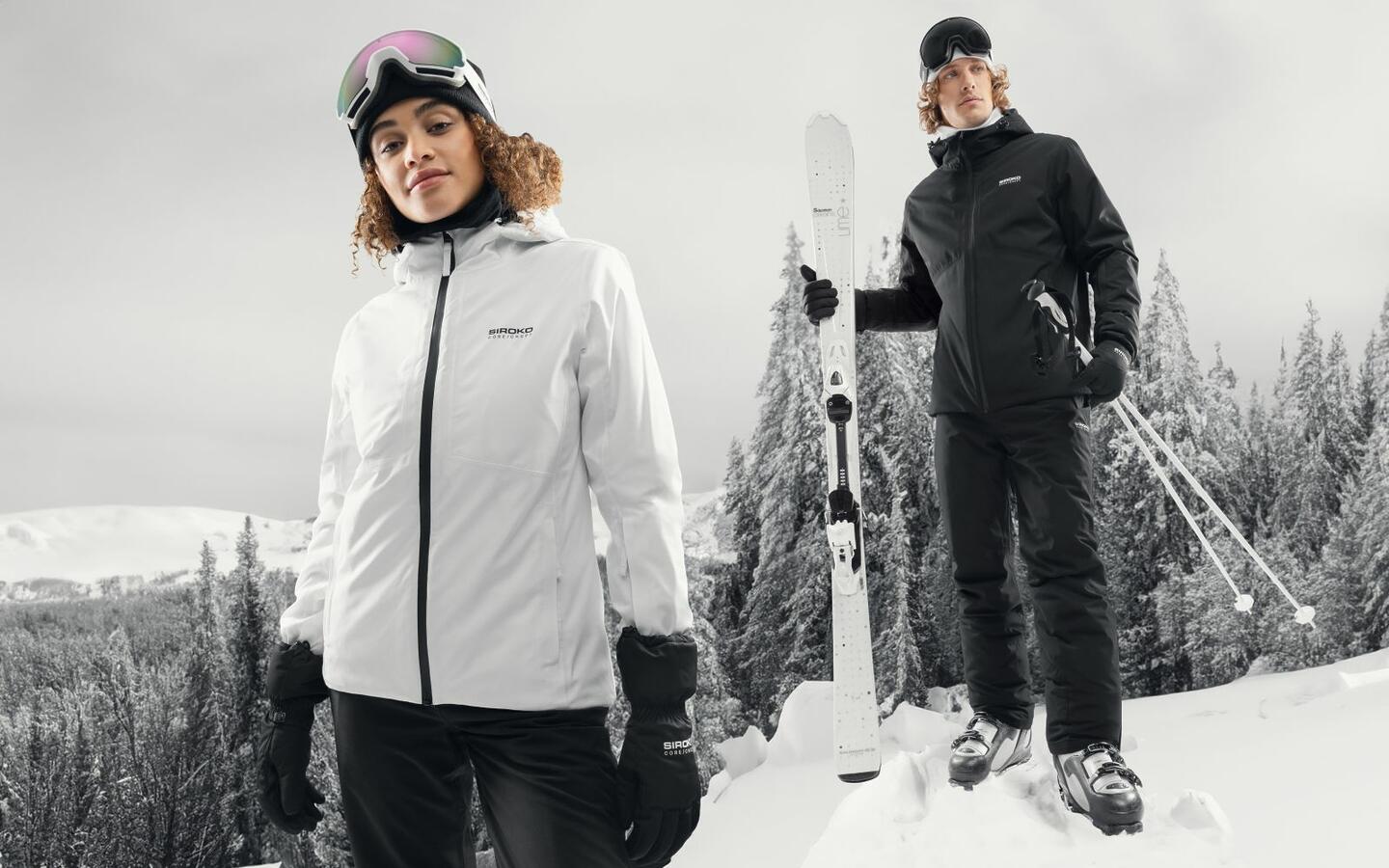There are various Siroko products with names that make cycling fans see everything through rose-colored glasses. Not only because some garments are actually pink but because those names refer to emblematic points of the Giro d’Italia. Today we are going to talk about Gavia-Mortirolo, mountain passes quite commonly connected in the corsa rosa.
Let’s start with the Gavia Pass, to which we have dedicated a pair of pink Siroko cycling sunglasses from our K3 collection. And it was the American cyclist Andrew Hampsten who got to wear the pink jersey after an epic and dreadful day of snow and freezing cold in the 1988 Giro. Today, that stage would not have been held, but on that day it was not cancelled despite the forecast. Perhaps the organizers wanted a TV show worthy of gladiators’ battles in Ancient Rome. If that was their goal, they didn’t exactly get all they wanted: due to the weather conditions it was impossible to broadcast what happened on the Gavia live, but the viewers could watch the trembling cyclists at the finish line:
The Gavia is a giant. 20 km from Ponte di Legno, 1300 meters of elevation gain at 6.6% average. It doesn’t seem like a lot, but the first 6 km are “easy”. The next 14 km go up averaging 8.5% grade with 10% ramps, adding stretches of unpaved, dirt road in 1988 (it was completely paved at the end of the 90’s).
The forecast was right. Rain and cold at the start. The riders went up and down Aprica. Some of them, freezing after the descent, looked as if they had seen a ghost. Shortly after the Gavia started, it began to snow and as they climbed the 2621 meter summit, it got even colder and snowier. That year, temperatures reached -5º on the Cima Coppi. Hampsten said it felt like home, riding to school in the snow on gravel roads of Colorado. He reached the summit 47 seconds ahead of the maglia rosa, Italy’s Franco Chioccioli. But the American’s biggest advantage wasn’t in those seconds, it was the team’s pre-race preparation. Team manager Jim Ochowicz and directeur sportif Mike Neel showed good judgment and bought snow gear for their riders the day before. At the top of the Gavia, Ochowicz was waiting for Hampsten with some extra layers and a hot drink for the descent.
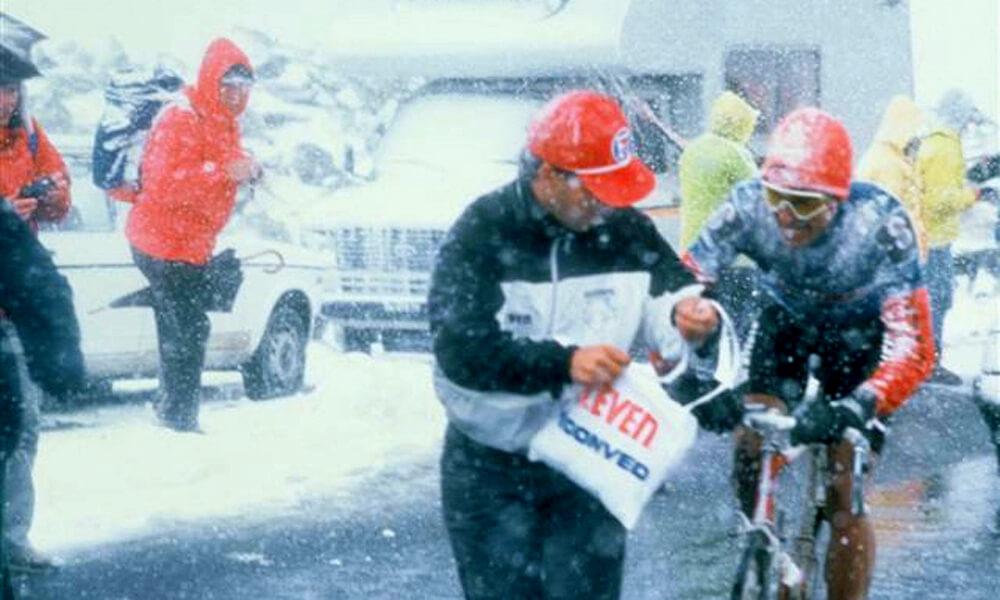
The American took off down the Gavia dirt road on his 7-Eleven Huffy, which was actually a Land Shark custom-made bike by American craftsman John Slawta, a man Hampsten has relied on since his years with Levi’s-Raleigh team. The team’s pre-race planning made all the difference in the race against Chioccioli, as going uphill, at maximum effort, the riders didn’t suffer the cold as much. Downhill is a different story and that’s when the cold became the Italian’s worst enemy. However, we’ve told you that some riders can handle the cold better than others. Erik Breukink (pictured below), wearing fingerless gloves and a cycling cap, ended up winning the stage after catching Hampsten at the end of the descent to Bormio.
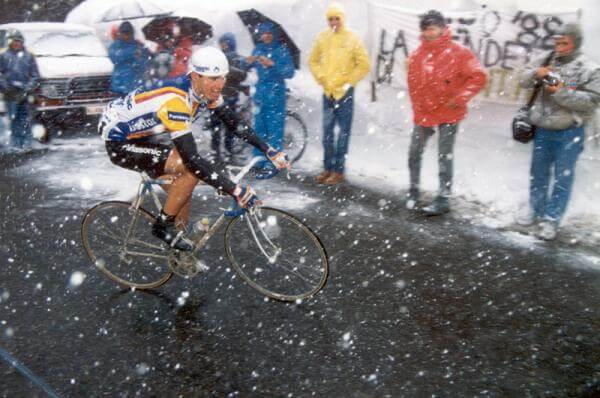
The descent was so freezing cold that Belgian Johan Van der Velde, who hit the Gavia summit first, wearing a short-sleeved jersey, had to stop on the way down to warm up and then ride back up the climb seeking warm clothes. He lost 47 minutes. The leader, Franco Chioccioli, arrived within the following 5 minutes. His face says it all.
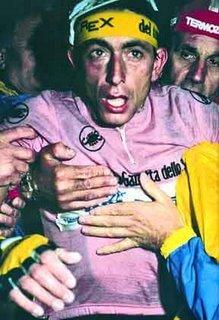
The Italian could have used a winter jacket such as those from Siroko to face the 26 km from the summit to Bormio. The Siroko K3 Gavia sport sunglasses combined with an anti-fog lens would have helped him see a little better on the descent and would have looked great combined with the maglia rosa that he lost that day to Hampsten. The American’s bravery along with excellent team planning and proper equipment made him the first and only American to ever win the Giro. Can young Brandon McNulty become the second to achieve this by winning the 2021 edition? Who knows. What we do know is that the Gavia Pass is not going to be the critical point this year as it is no longer part of the corsa rosa, nor is the dreaded climb that follows.
The Mortirolo was an inspiration to create extra comfortable bib shorts, with a soft, breathable chamois and light, firm suspenders to provide a snug fit and keep the bib shorts in place when you move on and off the saddle turning left and right, as that is what cyclists do on climbs like the Mortirolo. A climb that is equally rough and popular, visited by bike tourists and cycling enthusiasts who gather in its ditches to watch the Giro.
For the pros it’s a nightmare, they hate it. If they could, they would choose any other nearby Alpine giant instead of having to face the ramps of the Mortirolo. As sprinter Mark Cavendish says: “It’s savage, f**king savage – unbelievably steep and it just goes on and on. If you asked me for three words to sum it up, I’d say steep, long and sick!”. Geraint Thomas adds to it: “There are points on the Mortirolo when you wonder if it’s ever going to end. You’ve been climbing so slowly that your Garmin has auto-paused, assuming that you’ve stopped”
The truth is that the Mortirolo is a fairly recent ascent as it was climbed for the first time on the Monno side (its less known slope) in the 1990 Giro. The extremely hard climb from Mazzo was opened the following year, marking the beginning of a whole series of new climbs sometimes referred to as “goat paths” by cycling fans (L’Angliru, Zoncolan… anywhere the concrete and organizers’ imagination goes). In the case of the Mortirolo they are not too far off track, since before it was paved, it was a road used by shepherds to drive their cattle up to the pastures.
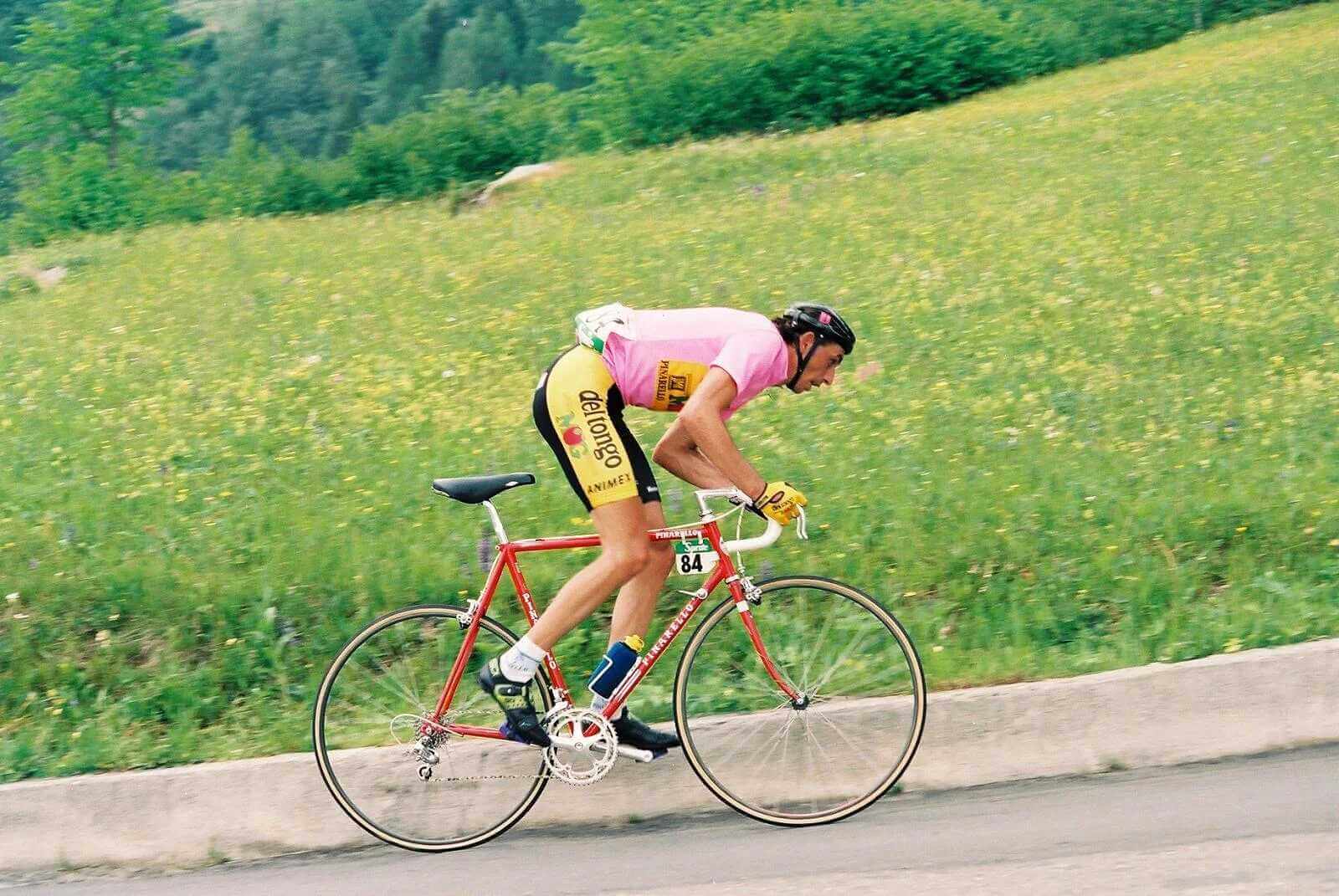
Imagine the riders’ surprise in 1991 when they faced the exhausting ascent of Mazzo with a 42-tooth small chainring and a 24-tooth large rear sprocket. You have to eat plenty of bresaola della Valtellina so that your muscles don’t explode with those gear ratios. In comparison: the most recent times it has been climbed, the riders used a small 34-tooth chainring and a large 30-tooth rear sprocket. So if at some point you should decide to give it a try, make sure you’ve got the right gears and be patient. The bike resists, the tire rubs against the rough road, it seems like it just won’t move forward. This magnetism is called gravity.
Goats run around in the mountains and do not always choose the same paths, nor do all the shepherds live in the same village and so, besides the two slopes mentioned above, there are other options for climbs. One of them, from Tovo di Sant’Agata, was done in the 2012 Giro. It is arguably even harder than the one from Mazzo as the average elevation gain would be higher if it weren’t for a couple of kms of descent 5 kms from the top.
- Ascent from Monno: 12 km, elevation gain 1000 m, maximum altitude 1852 meters, maximum gradient 16%, average gradient 7.5%.
- Ascent from Mazzo: 12.2 km, elevation gain 1307 m, maximum altitude 1852 meters, maximum gradient 20%, average gradient 10.7%.
- Ascent from Tovo di Sant’Agata: 12.5 km, elevation gain 1323 m, maximum altitude 1852 m, maximum gradient 23%, average gradient 10.6%.
Halfway up the climb from Mazzo, in Piaz de l’Acqua, there is a sculpture in memory of Marco Pantani and his 1994 jaw-dropping performance. Five years later Pantani was preparing to climb it again but was disqualified after a blood test showing that his hematocrit exceeded 50%. The mafia was responsible, as it was officially proven many years later. Il Pirata had been robbed.
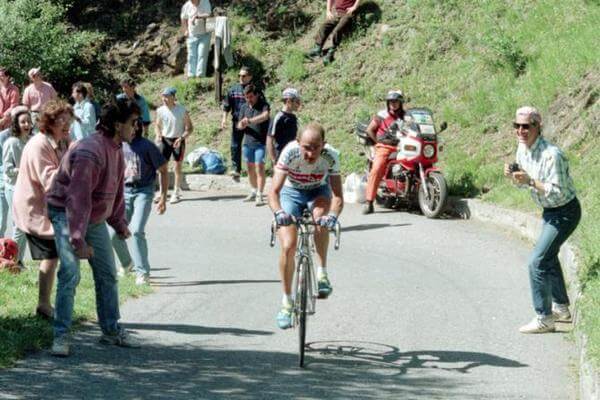
With 2 stages to go in the 1996 Giro, Spaniard Abraham Olano had taken the lead after a time trial. There was “only” one more wild ride before reaching Milan: 250 km long and 6000 meters of elevation gain that begun at the Passo della Mendola, continued at the Passo del Tonale and ended at today’s Gavia-Mortirolo leg, 30 km from the finish line in Aprica. Olano endured until the Mortirolo, where he finally gave in to the gravity. With over 70 kg he stood no chance against the Russians Tonkov and Ugrumov, and the Italians Gotti and Zaina, all weighing only slightly over 60 kg. He lost the Giro and held on to the third step of the podium by only three seconds. This year, neither Mortirolo, nor Gavia won’t be the critical points of the corsa rosa, but surely the Zoncolan, Pordoi, San Bernardino, Giau…and other great climbs of the 2021 Giro will take their place.
